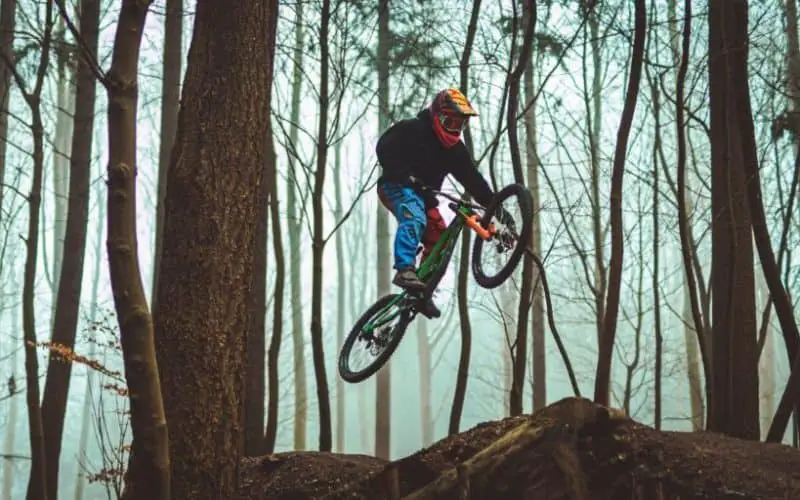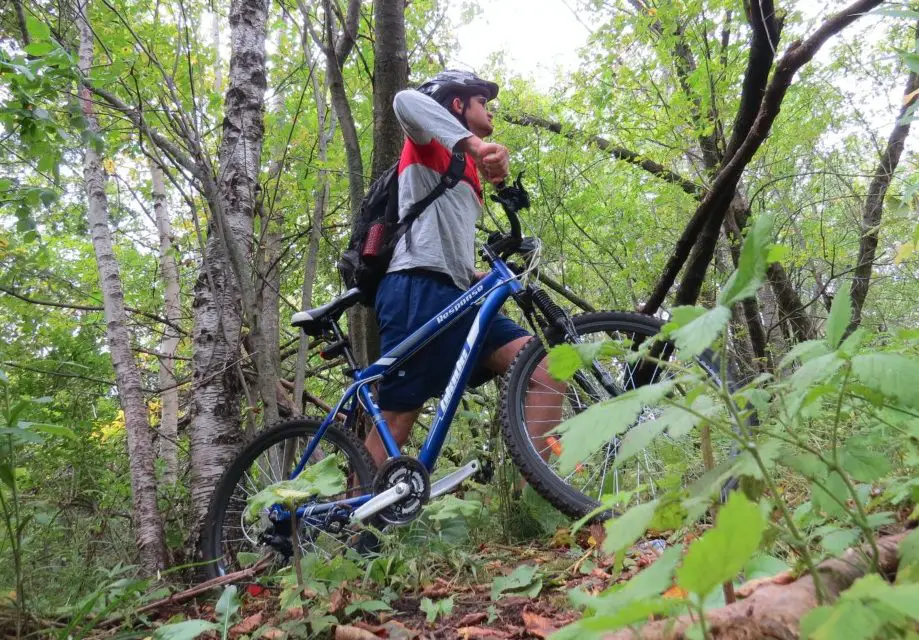When 29ers first arrived on the mountain biking scene, most people thought they were ridiculous. Those big, slow, awkward machines would never be able to keep up with nimble 26 inch bikes!
How times have changed.
It’s been over 20 years since the introduction of the 29er, and they now reign supreme as the most popular wheel size on the trails…and aside from a few dirt jumpers, bike companies have completely phased out the 26 inch wheel! But are 29ers better at sending jumps or tackling climbs than the most recent addition to the market: the 27.5?
29ers and 27.5 bikes tend to have comparable performance when it comes to jumping. 29ers carry more speed downhill, which offsets their slightly heavier weight on jumps. For climbing hills, 29ers may take more effort to accelerate, but they also roll over obstacles more easily, helping you maintain momentum.
If you find yourself jumping and climbing a lot on your rides, let’s take a closer look at how a 29er performs in these areas.
Are 29ers Harder to Jump / Bunny Hop?

No doubt about it: bigger wheels and tires are going to be heavier. But heavy enough to make jumping, manualing or bunny hopping that much more difficult? Doubtful.
A pair of Maxxis Minion DHF 27.5 x 2.30 tires weighs 4.1 lbs. The same set of tires for a 29er weighs 4.5 lbs.
An entry level DT Swiss wheelset in 29er is about 0.2 lbs heavier than the 27.5 version.
If you think an extra 0.6 lbs is preventing you from being able to get your wheels in the air, it’s probably not the weight; you need to work more on your technique!
Larger wheels roll faster downhill and hold their speed better than smaller wheels. This offsets the slight weight penalty when jumping. 29ers also have a larger contact patch with the ground, meaning a larger balance point when performing manuals, wheelies and bunny hops.
Does this mean these tricks and techniques are easier with 29ers as opposed to 27.5 bikes? Not necessarily. But they also aren’t more difficult!
Are 27.5 and 26 Wheels Better for Jumping?
To answer this, we need to identify the style of jumping we’re referring to.
Some trails are composed only of jumps. You’ll mostly find these dirt jump or slopestyle courses at parks specifically designed for this kind of riding. They usually feature a long series of jumps back to back, without any other trail obstacles in between.
Just like a designated downhill bike has the advantage on downhill trails, a dirt jumper will be better on this type of jump trail. These bikes usually feature 26 inch or sometimes 27.5 inch wheels.
Smaller wheels accelerate faster, which is helpful when hitting subsequent jumps in quick succession. They’re also more playful and maneuverable in the air, making them popular with riders looking to add style to their jumps.
If your trails only have the occasional jump, or if you ride jump trails at a downhill bike park – where there are a lot of back to back jumps, but you still have to ride over some gnarly terrain to get there! – a 29er would be just as capable as a 27.5, and definitely more capable than a 26.
The larger wheel’s increased stability at higher speeds is a huge advantage over the 26 inch wheel size in a bike park.
Are 29ers Better for Climbing?

When it comes to climbing, both main wheel sizes (29er and 27.5) have pros and cons.
Heavier wheels and tires will take a little more effort to get up to speed on the climbs, but they’ll roll over obstacles much easier, allowing you to maintain your momentum. If your climbs are anything but smooth, you’ll appreciate this a lot…because it’s frustrating to struggle the whole way up, only to be stopped dead when your tire hits a big root or rock.
My bike has 27.5 wheels, and this has happened to me more times than I can count (of course, it’s got a lot to do with my lack of endurance too!) While climbing, your seat is probably all the way up, so when you come to a sudden stop, you try to put a foot down…only to realize you can’t reach the ground.
Thus ensues the awkward single leg hopping while you fumble with your dropper post lever to try and get your seat down before you topple over! I have about a 50% success rate with reaching the lever before tumbling to the ground in a heap, with my bike crashing down on top of me. All you can hope is that nobody is around to see it…
So why did I go 27.5 instead of 29er? Well, I don’t really care too much about summiting climbs like a mountain goat. I’ll trade better obstacle clearance for faster acceleration and better maneuverability.
But that’s just my personal preference. If I was a cross-country rider who prioritized climbing performance, I’d have bought a short travel 29er, no doubt about it!
Is this a thought you have in mind, “Can You Put 700c Wheels on a 29er?” Read our separate article to find out.
How Tall Should You Be for a 29er?
This may be a controversial statement, but it’s true, so…here it goes…
When it comes to wheel size, your height doesn’t matter very much!
A bike frame is specifically designed around the wheel size it uses. So you couldn’t buy a 29er and decide to slap 27.5 wheels on it instead. This independent design process means that a 29er bike won’t be much–if any–higher off the ground than a 27.5, so standover height shouldn’t be an issue even if you’re a shorter rider.
It’s much more important to look at frame size for the specific model of bike you want to get. This correlates directly to your height. Get the right frame size, and you’ll be equally comfortable on a 27.5 or a 29er.
Despite this, you may notice some brands only offer their smallest frame sizes with 27.5 wheels, while M through XL are only offered in 29er. Other brands may give you the choice of wheel sizes with larger frames, but limit smaller frame sizes to the smaller wheels.
I’m not a big fan of this. However, if there is a measurement that affects wheel size choice, it would be leg length, not overall height. When going down rough technical terrain, you shift your weight over the back of the bike to improve handling. If you have short legs and ride a 29er, you may find the rear wheel hits your butt when you do this…
Yep, it’s a real thing that happens! That’s why you’ll see a lot of pro downhill and enduro racers with short legs running a 27.5 bike.
There is, however, a way to have the control and stability of a 29er while saving your butt from getting chewed up by the rear tire.
Get a mullet!
No, I don’t mean the hairstyle–please don’t get that. I mean a mullet bike!
Mullet bikes are quickly gaining popularity among racers and early tech adopters alike. A 29er wheel up front is all business–providing high speed stability and better obstacle clearance–while a 27.5 in the back brings the party–with more maneuverability and faster acceleration.
If you’re a shorter rider or have short legs, you don’t have to be limited to 27.5 wheels if you’d really prefer a 29er. Even if you’re taller and just want to try out the latest mountain biking innovation, a mullet bike may be for you! I’m thinking my next bike may be a mullet…
29er, 27.5, or Mullet: Which Will You Choose?
They may have taken a while to be accepted by the mountain biking community, but 29ers are here to stay. In fact, I bet a lot of those people who thought 29ers were ridiculous now look at 26 inch wheels in the same way.
When it comes down to it, you can’t go wrong with a 29er or a 27.5–or a mixed wheel mullet. Both have their pros and cons, but in reality, the differences are so subtle that you probably won’t even notice unless you’re an advanced rider with years of biking experience. I’ve ridden both, and I love both…though I still want to try a mullet.
The best way to get better at jumping, climbing or whatever skill you’re working on is to just get out and ride! Consistent practice is going to serve you well no matter which wheel size you choose!
